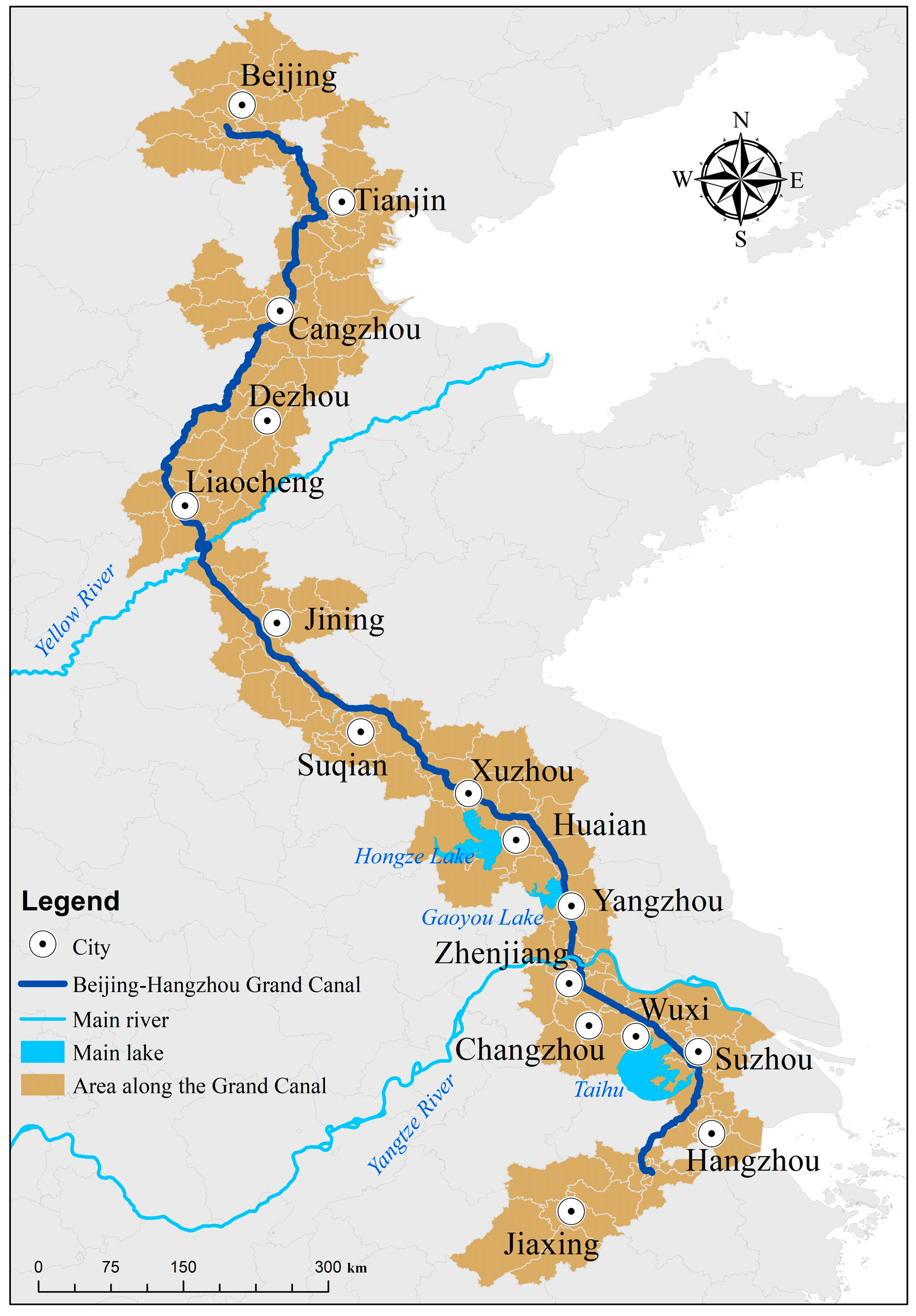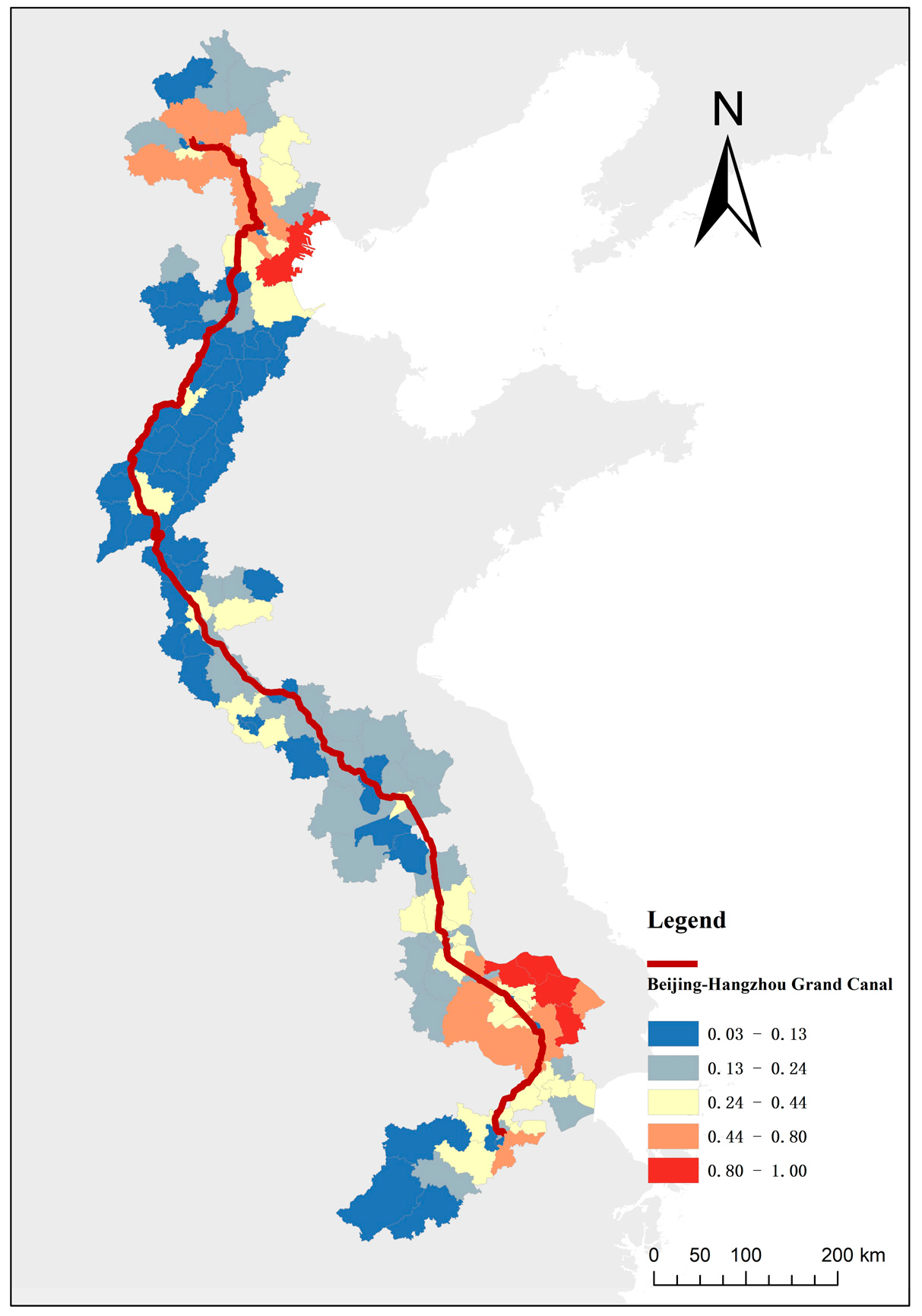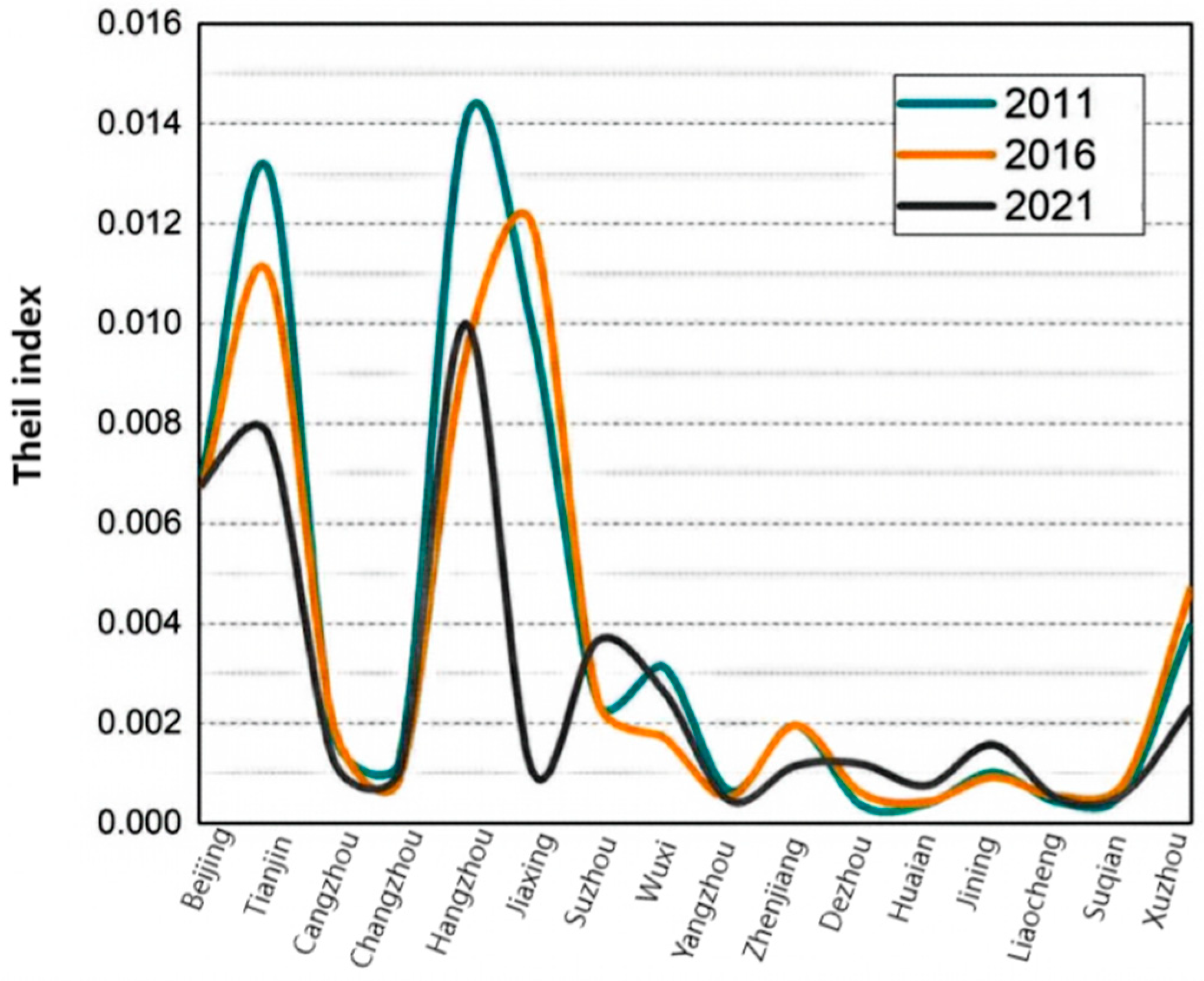Analysis of Regional Social–Economic Spatial Pattern and Evolution along the Beijing–Hangzhou Grand Canal
Abstract
:1. Introduction
2. Literature Review
3. Materials and Methods
3.1. Data Sources
3.2. Methods
3.2.1. Entropy Weight Method
3.2.2. Moran Indices
3.2.3. Theil Index
3.3. Indicator Construction
4. Analysis of the Spatial Pattern of The Current Social–Economic Situation in the Region along the Grand Canal
4.1. Characteristics of the Current Social–Economic Situation
4.2. Relevance of Regional Social–Economic Status
5. Analysis of the Spatial and Temporal Evolution of Regional Social–Economics along the Grand Canal
5.1. Analysis of Regional Correlation Evolution
5.2. Analysis of the Evolution of Regional Differences
6. Conclusions and Discussion
6.1. Conclusions
6.2. Discussion
Author Contributions
Funding
Data Availability Statement
Acknowledgments
Conflicts of Interest
References
- Wang, W.; Chen, Y.; Wang, X.W. A study on spatial-temporal patterns of regional development disparities in Yangtze River Economic Zone. Resour. Environ. Yangtze Basin 2017, 26, 1489–1497. [Google Scholar]
- Rozelle, S. Rural industrialization and increasing inequality: Emerging patterns in China’s reforming economy. J. Comp. Econ. 1994, 19, 362–391. [Google Scholar] [CrossRef]
- Yu, L.; Jiang, Y.T. Spatial and Temporal Analysis on the Regional Economic Disparities in China: Based on the Comparison between the Whole Country and Three Megalopoleis. J. Financ. Econ. 2007, 33, 18–29. [Google Scholar]
- Yang, H.; Liu, J.; Wang, T. Analyzing economic spatial-temporal disparities at county level in Yangtze River Delta based on ESDA-GIS. In Advanced Research on Electronic Commerce, Web Application, and Communication, Proceedings of the International Conference, ECWAC 2011, Guangzhou, China, 16–17 April 2011; Springer: Berlin/Heidelberg, Germany, 2011; pp. 185–191. [Google Scholar]
- Lu, M.; Wang, E. Forging ahead and falling behind: Changing regional inequalities in post-reform China. Growth Chang. 2002, 33, 42–71. [Google Scholar] [CrossRef]
- Zhang, Z.; Hu, Z.; Zhong, F.; Cheng, Q.; Wu, M. Spatio-Temporal Evolution and Influencing Factors of High Quality Development in the Yunnan–Guizhou, Region Based on the Perspective of a Beautiful China and SDGs. Land 2022, 11, 821. [Google Scholar] [CrossRef]
- Yang, G.; Ma, X. Spatial and temporal difference of county economy development level in Jiangsu Province during 2005–2015. In Journal of Physics: Conference Series; IOP Publishing: Bristol, UK, 2018; Volume 1087, p. 032009. [Google Scholar]
- He, S.; Liao, F.H.; Li, G. A spatiotemporal analysis of county economy and the multi-mechanism process of regional inequality in rural China. Appl. Geogr. 2019, 111, 102073. [Google Scholar] [CrossRef]
- Liu, T.; Zhou, B. Evaluation and obstacle factors of high-quality development in coastal cities along the Yangtze River. Ocean Coast. Manag. 2023, 244, 106818. [Google Scholar] [CrossRef]
- Li, H.; Wei, Y.D.; Swerts, E. Spatial inequality in the city-regions in the Yangtze River Valley, China. Urban Stud. 2020, 57, 672–689. [Google Scholar] [CrossRef]
- Pak, M.S. Study on the Economic Development of Suez Canal Region with the Opening of Suez Canal. J. Mediterr. Area Stud. 2008, 10, 1–32. [Google Scholar]
- Chen, M.; Wang, J.; Sun, J.; Ye, F.; Zhang, H. Spatio-Temporal Distribution Characteristics of Intangible Cultural Heritage and Tourism Response in the Beijing–Hangzhou Grand Canal Basin in China. Sustainability 2023, 15, 10348. [Google Scholar] [CrossRef]
- Yang, J.; Hu, D.; Chen, Z.; Xu, Y.; Zou, Z.; Zhu, Y. Analysis of Spatial and Temporal Distribution Patterns of Traditional Opera Culture along the Beijing–Hangzhou Grand Canal. ISPRS Int. J. Geo-Inf. 2023, 12, 477. [Google Scholar] [CrossRef]
- Zhang, S.; Liu, J.; Pei, T.; Chan, C.S.; Wang, M.; Meng, B. Tourism value assessment of linear cultural heritage: The case of the Beijing–Hangzhou Grand Canal in China. Curr. Issues Tour. 2021, 26, 47–69. [Google Scholar] [CrossRef]
- Zhang, F.; Yang, L.; Luo, X. A Study on the Distribution and Utilization of Recreational Resources along the Grand Canal Culture Belt. Chin. J. Urban Environ. Stud. 2023, 7, 1950015. [Google Scholar] [CrossRef]
- Shi, F.; Lu, Y.; Wu, F.; Wang, C.; Hsu, W.L. Evaluation of Green Cities in the Drainage Area of China’s Beijing–Hangzhou Canal. Water 2021, 13, 2145. [Google Scholar] [CrossRef]
- Huang, Y.; Yang, S. Spatio-temporal evolution and distribution of cultural heritage sites along the Suzhou canal of China. Herit. Sci. 2023, 11, 188. [Google Scholar] [CrossRef]
- Zhao, Y.; Bian, G.; Sun, T.; Yan, J. The In-Situ Spatial-Temporal Evolution of the Settlement Space along the Grand Canal Tianjin Section from the Perspective of Cultural Heritage. Land 2023, 12, 1023. [Google Scholar] [CrossRef]
- Zhang, Y.; Tian, Q.; Wu, J. Coupling coordination degree and obstacle factors between the tourism industry and ecological environment in the Beijing-Hangzhou Grand Canal Basin, China. Environ. Dev. Sustain. 2023, 26, 2589–2613. [Google Scholar] [CrossRef]
- Tong, D. The Mechanism of Ecological and Cultural Collaborative Construction of the Beijing Hangzhou Grand Canal Cultural Belt. In Proceedings of the 2022 6th International Seminar on Education, Management and Social Sciences, Suzhou, China, 25–26 June 2022; pp. 557–565. [Google Scholar]
- Pan, S.; Ren, G.; Ma, Y.; Zhang, J.; Tong, D. The inheritance and coordinated utilization of intangible cultural heritage in the Beijing-Tianjin-Hebei section of the Beijing-Hangzhou Grand Canal. In Proceedings of the 2nd International Conference on Public Relations and Social Sciences (ICPRSS 2022), Changsha, China, 23–25 September 2022; EDP Sciences: Les Ulis, France, 2022; Volume 148. [Google Scholar]
- Cheng, Z.; He, J.; Li, Y.; Zhu, Y.; Dai, J. Coupling-Coordinated Development of the Water-Economy-Innovation Nexus: A Case Study of the Grand Canal Area in China. J. Water Resour. Plan. Manag. 2023, 149, 05023016. [Google Scholar] [CrossRef]
- Sun, J.; Yi, S. The Construction of the Grand Canal Cultural Belt and the Remodeling of China’s Regional Spatial Patterns. Nanjing J. Soc. Sci. 2019, 1, 11–16+33. [Google Scholar] [CrossRef]
- Hua, X.; Lv, H.; Jin, X. Research on High-Quality Development Efficiency and Total Factor Productivity of Regional Economies in China. Sustainability 2021, 13, 8287. [Google Scholar] [CrossRef]
- Cao, J.; Wang, S.; Fan, X.; Yang, X.; Zheng, H. Correlation analysis of regional carbon emission intensity and green industry development-A case study of Chengdu-Chongqing region. Heliyon 2023, 9, e21683. [Google Scholar] [CrossRef]
- Pei, Z.J.; Chong, P.; Ma, L.S. Macroeconomic uncertainty, high-level innovation, and urban green development performance in China. China Econ. Rev. 2019, 55, 1–18. [Google Scholar]
- Shang, F.L. Liang Shan Prefecture’s Excellent Traditional Culture Boosts Regional High-Quality Development. Acad. J. Humanit. Soc. Sci. 2021, 4, 76–80. [Google Scholar]
- Wang, D.; Zhang, E.; Liao, H. Does Fiscal Decentralization Affect Regional High-Quality Development by Changing Peoples’ Livelihood Expenditure Preferences. Provincial Evidence from China. Land 2022, 11, 1407. [Google Scholar] [CrossRef]
- Zhao, A.; Wang, J.; Sun, Z.; Guan, H. Research on the Evolutionary Path of Eco-Conservation and High-Quality Development in the Yellow River Basin Based on an Agent-Based Model. Systems 2022, 10, 105. [Google Scholar] [CrossRef]
- Shi, L.F.; Huang, X.J. Spatiotemporal differences of urban expansion along China’s Grand Canal. Prog. Geogr. 2019, 38, 1206–1216. [Google Scholar] [CrossRef]
- Chun, H.Z.; Yue, P.N. Study on the effects of Grand Canal on city pattern change of Hangzhou based on Remote Sensing. In Proceedings of the 2009 Joint Urban Remote Sensing Event, Shanghai, China, 20–22 May 2009; pp. 1–6. [Google Scholar]
- Li, J.; Zhang, H.; Sun, Z. Spatiotemporal variations of land urbanization and socioeconomic benefits in a typical sample zone: A case study of the Beijing-Hangzhou Grand Canal. Appl. Geogr. 2020, 117, 102187. [Google Scholar] [CrossRef]
- Zhou, W.; Li, X.J. A Comprehensive Evaluation Method Based on Information Entropy. Sci. Technol. Eng. 2010, 10, 5839–5843. [Google Scholar]
- Moran, P.A.P. Notes on Continuous Stochastic Phenomena. Biometrika 1950, 37, 17–23. [Google Scholar] [CrossRef]
- Conceição, P.; Ferreira, P. The Young Person’s Guide to the Theil Index: Suggesting Intuitive Interpretations and Exploring Analytical Applications. 2000. Available online: https://papers.ssrn.com/sol3/papers.cfm?abstract_id=228703 (accessed on 1 January 2023).






| Primary Indicators | Secondary Indicators | Calculation | Character | Weight |
|---|---|---|---|---|
| Economic growth | GDP growth | GDP/Last GDP | plus | 0.0783 |
| Percentage of secondary sector output | Percentage of secondary sector output/total production value | plus | 0.0786 | |
| Percentage of tertiary sector output | Percentage of secondary sector output/total production value | plus | 0.0779 | |
| Urbanization rate | Urbanization population/total population | plus | 0.0787 | |
| Luminous remote sensing DN value | DN value/number of pixels | plus | 0.0735 | |
| Annual electricity consumption | Total annual electricity consumption | plus | 0.0758 | |
| Livelihood benefits | Disposable income per capita | Personal income—taxes | plus | 0.0776 |
| Number of practicing physicians per 1000 people | Number of practicing physicians/population × 1000 | plus | 0.0773 | |
| Number of kindergartens | Total number of kindergartens | plus | 0.0779 | |
| Green ecology | Greening coverage rate of built-up areas | Total greening area/total urban land area | plus | 0.0784 |
| PM2.5 concentration | PM2.5 content/air concentration | minus | 0.0779 | |
| Innovation drive | Number of invention patents per 10,000 people | Number of invention patents/population × 10,000 | plus | 0.0722 |
| Food guarantee | Annual food production per capita | Annual food production/resident population | plus | 0.0753 |
| District | Economic Growth | Livelihood Welfare | Green Ecology | Innovation Drive | Food Guarantee | Comprehensive Index |
|---|---|---|---|---|---|---|
| Baochen | 0.142 | 0.289 | 0.312 | 0.043 | 0.108 | 0.286 |
| Beichen | 0.301 | 0.260 | 0.256 | 0.054 | 0.086 | 0.494 |
| ... | ... | ... | ... | ... | ... | ... |
| ... | ... | ... | ... | ... | ... | ... |
| ... | ... | ... | ... | ... | ... | ... |
| Chaoyang | 0.452 | 0.711 | 0.404 | 0.217 | 0.001 | 0.686 |
| Renping | 0.114 | 0.209 | 0.195 | 0.001 | 0.716 | 0.122 |
| Chunan | 0.063 | 0.193 | 0.966 | 0.038 | 0.108 | 0.076 |
| Daxing | 0.355 | 0.262 | 0.386 | 0.137 | 0.007 | 0.586 |
| Economic Growth | Livelihood Benefits | Green Ecology | Innovation Drive | Food Guarantee | Comprehensive Index | |
|---|---|---|---|---|---|---|
| Moran index | 2.44 | 3.64 | 1.99 | 1.23 | 0.88 | 0.35 |
| P | 0.05 | 0.01 | 0.01 | 0.02 | 0.06 | 0.09 |
| Z | 2.46 | 3.77 | 2.46 | 2.27 | 1.98 | 1.96 |
| Spatial Association Patterns | Economic Growth | Livelihood Benefits | Green Ecology | Innovation Drive | Food Guarantee | Comprehensive Index |
|---|---|---|---|---|---|---|
| High aggregation | Changping Yuhang etc. | Changping | Suzhou Wuxi etc. | Xuzhou Beijing etc. | District between Dongping and Botou County | Suzhou Hangzhou etc. |
| High–low dispersion | Xihu Ninghe etc. | Xiaoshan Mentougou | Jiawang Tongshan | Shunyi etc. | Decheng | None |
| Low aggregation | Cangzhou Liaocheng etc. | District between Fengxian and Renqiu | Jining etc. | Suqian etc. | Xuzhou Beijing etc. | Cangzhou Liaocheng etc. |
| High–low dispersion | Jining Rencheng | None | None | Juning Jingkou | None | Cangzhou Decheng etc. |
| No patterns | Others | Others | Others | Others | Others | Others |
| Index | 2011 | 2016 | 2021 |
|---|---|---|---|
| values | 0.11 | 0.24 | 0.39 |
| P | 0.05 | 0.01 | 0.01 |
| Z | 1.46 | 2.77 | 2.37 |
| 2011 | 2016 | 2021 | 2016 Growth Rate (%) | 2021 Growth Rate (%) | |
|---|---|---|---|---|---|
| Beijing | 0.070 | 0.068 | 0.068 | −3.58 | 0.55 |
| Tianjin | 0.131 | 0.110 | 0.078 | −15.77 | −29.48 |
| Cangzhou | 0.018 | 0.017 | 0.022 | −2.42 | 29.77 |
| Changzhou | 0.013 | 0.009 | 0.011 | −29.76 | 18.07 |
| Hangzhou | 0.141 | 0.094 | -0.045 | −33.36 | −52.01 |
| Jiaxing | 0.003 | 0.003 | 0.001 | 15.18 | −78.80 |
| Suzhou | 0.024 | 0.025 | 0.037 | 1.69 | 47.91 |
| Wuxi | 0.031 | 0.017 | 0.026 | −45.09 | 53.69 |
| Yangzhou | 0.007 | 0.005 | 0.005 | −20.55 | −12.06 |
| Zhenjiang | 0.020 | 0.020 | 0.011 | 0.08 | −41.53 |
| Dezhou | 0.004 | 0.006 | 0.012 | 67.21 | 94.87 |
| Huaian | 0.004 | 0.004 | 0.008 | 11.27 | 76.47 |
| Jining | 0.010 | 0.009 | 0.016 | −9.94 | 71.59 |
| Liaocheng | 0.004 | 0.005 | 0.005 | 28.00 | −0.08 |
| Suqian | 0.006 | 0.008 | 0.006 | 33.23 | −28.66 |
| Xuzhou | 0.040 | 0.047 | 0.023 | 18.11 | −50.44 |
| Intra-regional | 0.125 | 0.148 | 0.127 | −14.62 | −6.82 |
| Inter-regional | 0.137 | 0.230 | 0.291 | 67.70 | 26.44 |
| Total differences | 0.162 | 0.178 | 0.167 | 2.44 | −1.60 |
Disclaimer/Publisher’s Note: The statements, opinions and data contained in all publications are solely those of the individual author(s) and contributor(s) and not of MDPI and/or the editor(s). MDPI and/or the editor(s) disclaim responsibility for any injury to people or property resulting from any ideas, methods, instructions or products referred to in the content. |
© 2024 by the authors. Licensee MDPI, Basel, Switzerland. This article is an open access article distributed under the terms and conditions of the Creative Commons Attribution (CC BY) license (https://creativecommons.org/licenses/by/4.0/).
Share and Cite
Bian, D.; Zhang, M.; Kong, L.; Huang, B.; Hu, D. Analysis of Regional Social–Economic Spatial Pattern and Evolution along the Beijing–Hangzhou Grand Canal. Sustainability 2024, 16, 1527. https://doi.org/10.3390/su16041527
Bian D, Zhang M, Kong L, Huang B, Hu D. Analysis of Regional Social–Economic Spatial Pattern and Evolution along the Beijing–Hangzhou Grand Canal. Sustainability. 2024; 16(4):1527. https://doi.org/10.3390/su16041527
Chicago/Turabian StyleBian, Duo, Mengying Zhang, Lili Kong, Bingbing Huang, and Di Hu. 2024. "Analysis of Regional Social–Economic Spatial Pattern and Evolution along the Beijing–Hangzhou Grand Canal" Sustainability 16, no. 4: 1527. https://doi.org/10.3390/su16041527





